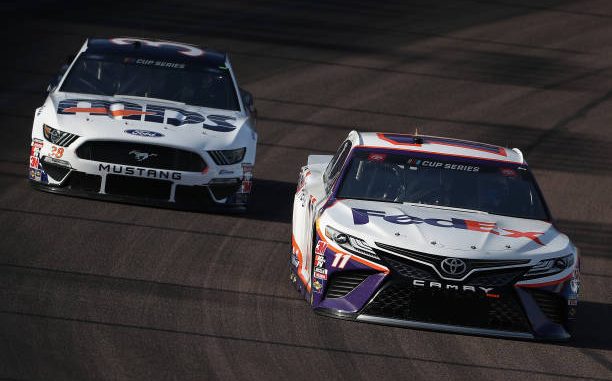
The PJ1 traction compound is applied lower in the corners.
The NASCAR Cup Series cars feature a much smaller spoiler and substantially lower downforce.
That adds up to an unknown—and potentially volatile—recipe for Sunday’s FanShield 500 at Phoenix Raceway (3:30 p.m. ET on FOX, MRN and SiriusXM NASCAR Radio).
“The tires are wearing out quicker,” driver Ty Dillon said after shaking down his No. 13 Chevrolet in practice. “You can’t just go out there, be mindless driving, and get the car to run the fastest lap. Things are coming back into play in taking care of your tires again, being a smart driver with your equipment.”
Denny Hamlin also thinks the traction compound will be more of a factor on Sunday than it was in November, when his eleventh-hour victory at the one-mile track secured a spot in the Championship 4 race at Homestead-Miami Speedway.
“It will play a factor,” Hamlin asserted. “I will be interested to see how it plays out in (Saturday’s) Xfinity race and see if those guys make their way up there. In the Cup race, we always seem to find lines that the other series really don’t. There’s enough experience where people know and trust it.
“I think it will be a factor, especially with it being slightly lower (toward the inside of the corners… It will be part of the racing for sure. I don’t think you’ll see much of it in practice. Not until the race, early to mid-stages will you see people go up there and using it.”
How much different the racing will be with all the new variables remains to be seen. One thing is certain, however. The Cup cars were on average seven-to-nine miles per hour slower in Friday’s practice than they were in advance of last year’s March race.
That’s not a bad thing. The lower downforce reduces cornering speeds and elevates the prospect of competitive racing throughout the field.
- Spire Motorsports confirms split with Corey LaJoie - July 25, 2024
- Kyle Larson wins NASCAR Brickyard 400 after overtime chaos - July 21, 2024
- Photos: NASCAR at the Brickyard Sunday July 21, 2024 - July 21, 2024